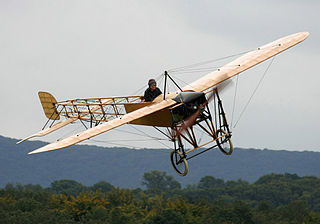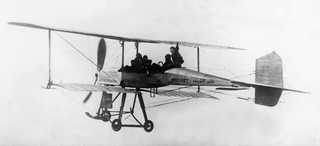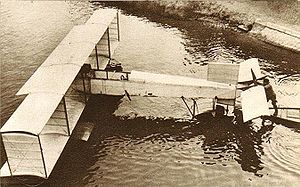
The Blériot XI is a French aircraft from the pioneer era of aviation. The first example was used by Louis Blériot to make the first flight across the English Channel in a heavier-than-air aircraft, on 25 July 1909. This is one of the most famous accomplishments of the pioneer era of aviation, and not only won Blériot a lasting place in history but also assured the future of his aircraft manufacturing business. The event caused a major reappraisal of the importance of aviation; the English newspaper The Daily Express led its story of the flight with the headline "Britain is no longer an Island".
Fabre Hydravion is the name used in English-language sources for an originally unnamed experimental floatplane designed by Henri Fabre. The aircraft is notable as the first to take off from water under its own power.

The Blériot V was an early French aircraft built by Louis Blériot in 1907 and was his first monoplane. Although Blériot only achieved a couple of short flights in it, the second resulting in a crash which damaged the aircraft beyond repair, it was the first of his experimental aircraft to achieve any measure of success.

The Antoinette military monoplane, also known as the Antoinette Monobloc or the Antoinette-Latham was an early 3-seat monoplane built in France in 1911 by the Antoinette company in the hope of attracting orders from the French military. It featured a futuristic and aerodynamic design with innovative elements that were ahead of its time, including unbraced cantilever wings, an enclosed fuselage and wheel fairings, and an engine with steam cooling and direct fuel injection. However, due to an under-powered engine, it was barely able to fly and failed to attract orders.

The Maurice Farman MF.7 Longhorn is a French biplane developed before World War I which was used for reconnaissance by both the French and British air services in the early stages of the war before being relegated to service as a trainer.

The Astra C was a 1912 French single engine biplane, manufactured by Société Astra at Villacoublay. In 1913, the Astra CM Hydro-avion three-seat floatplane version was used to make the world's first scheduled passenger-carrying flights.

Aéroplanes Voisin was a French aircraft manufacturing company established in 1905 by Gabriel Voisin and his brother Charles, and was continued by Gabriel after Charles died in an automobile accident in 1912; the full official company name then became Société Anonyme des Aéroplanes G. Voisin. During World War I, it was a major producer of military aircraft, notably the Voisin III. After the war Gabriel Voisin abandoned the aviation industry, and set up a company to design and produce luxury automobiles, called Avions Voisin.

The Morane-Borel monoplane was an early French single-engine, single-seat aircraft. It was flown in several European air races.

The 1907 Voisin biplane, was Europe's first successful powered aircraft, designed by aeronautical engineer and manufacturer Gabriel Voisin. It was used by the French aviator Henri Farman to make the first heavier-than-air flight lasting more than a minute in Europe, and also to make the first full circle. The first examples of the aircraft were known by the name of their owners, for instance the Delagrange I, or the Henri Farman n°1. Farman made many modifications to his aircraft, and these were incorporated into later production aircraft built by Voisin. The type enjoyed widespread success, and around sixty were built.

The Farman III, also known as the Henry Farman 1909 biplane, was an early French aircraft designed and built by Henry Farman in 1909. Its design was widely imitated, so much so that aircraft of similar layout were generally referred to as being of the "Farman" type.

The Nieuport IV was a French-built sporting, training and reconnaissance monoplane of the early 1910s.

The Breguet Type IV was an aircraft built by Breguet Aviation. It was first flown in 1911, and was the first Breguet aircraft to be produced in quantity. It was used by the French Army and the British Royal Flying Corps. It is notable for the extensive use of metal in its construction, unusual in an aircraft of its time.

The Nieuport II was a mid-wing monoplane racing or sport aircraft built by the Société Anonyme des Établissements Nieuport between 1910 and 1914 and was noted for its high performance using a small twin-cylinder engine, and winning many races, primarily in France before being used as a trainer during World War I by French flying schools.

The 1910 Deperdussin monoplane was the first aircraft to be built in significant quantities by Aéroplanes Deperdussin. The type was produced in a number of variants which were flown successfully in air races and gained several records during 1911, and was used by the Australian Central Flying School at Point Cook, Victoria. Several have survived, including an airworthy example in the Shuttleworth Collection in England.

The Voisin Type de Course was an early French aircraft built by Voisin Frères. It was first flown early in 1910.

The Paulhan biplane was a French experimental aircraft designed in 1910 by the successful aviator Louis Paulhan in collaboration with Henri Fabre. The prototype became the second aircraft bought by the British War Office: two further examples, differing in constructional detail, were built.
The Voisin Type Bordeaux was an aircraft built by Voisin Frères in 1910, so named because it was used by Juan Bielovucic to make a record-breaking flight from Paris to Bordeaux in France. The design differed significantly from previous Voisin designs in eliminating the forward-mounted elevator.
The Goupy Hydroaeroplane was a floatplane developed by Ambroise Goupy in 1912, which was displayed at the 1912 Paris Aero Salon. It was described in Flight as being generally comparable to a Goupy biplane designed by Alphonse Tellier displayed the year before, except for the change from wheels to a pair of pontoon-style floats. Janes 1913 stated that at least one had been built in 1912, and that the company was producing around 30 a year, but actual production numbers are not known beyond the 1912 demonstrator. An editorial review of the 1913 Paris Aero Salon bemoaned the lack of advancement in Goupy designs, with no display of a seaplane.
The Farman HF.10 was a reconnaissance aircraft built in France shortly before the First World War.

The Morane-Borel military monoplane was an unsuccessful French single-engine, multi-seat prototype aircraft built in 1911 for the Reims Military Aviation Competition hosted by the French Army. The aircraft only met one of the requirements and was eliminated from the competition.
















